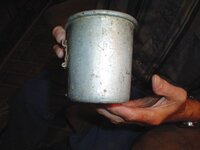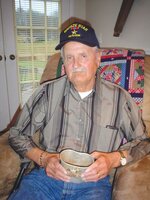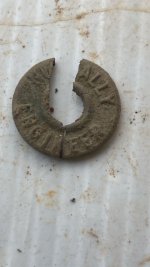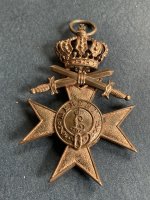That is a very cool story and a great deed! Thanks for sharing the experience with us!
You are using an out of date browser. It may not display this or other websites correctly.
You should upgrade or use an alternative browser.
You should upgrade or use an alternative browser.
🏆 HONORABLE MENTION Battlefield pickup returned to owner after 67 years!
- Thread starter wilkere
- Start date
ivan salis
Gold Member
- Feb 5, 2007
- 16,794
- 3,809
- 🏆 Honorable Mentions:
- 1
- Detector(s) used
- delta 4000 / ace 250 - used BH and many others too
this is what detecting is all about in my book.
Born Free
Sr. Member
- Oct 27, 2007
- 440
- 6
- Detector(s) used
- Minelab Xterra 705
- Primary Interest:
- Metal Detecting
Amazing you found him still alive, and able to appreciate you going to the trouble to find him and give him the momento. Wonderful story! When the paper runs a story, make sure you post it for us. I want to see a picture of Lody with his cup!
Born Free
Born Free
sneaky6
Full Member
Thank you for being an incredible ambassador for our hobby! You rock! Great story!! I agree with Born Free and want to see a picture of Lody and his cup!!
Godspeed,
Sneaky6
Godspeed,
Sneaky6
KyFreeBird
Hero Member
- Mar 21, 2009
- 834
- 3
nsdq
Silver Member
- Oct 16, 2011
- 4,031
- 1,923
- Detector(s) used
- AT-Pro,Ace 150, flea market digger
- Primary Interest:
- All Treasure Hunting
nicely sir,, i wish i was able too find people who fight in leyte gulf my grand dad was there and wounded,,,, his military recrods are lost also,,, ether way well done
civilman1
Gold Member
DittoMetal Magnet said:man, that is absolutely priceless. read like a book. great job!
wilkere
Full Member
- Thread starter
- #29
My website finally paid some dividends! http://www.okinawarelics.com
Newpaper article from veterans hometown.
Salyers remembers horror of Pacific fighting
JEFF LESTER News Editor
PINE CAMP - In 1981, a young American serviceman named Marty Black made his first trip to the Japanese island of Okinawa.One day, he was walking along Kakazu Ridge, the site of a major Japanese defensive line against an Allied invasion in the spring of 1945.Lasting more than 80 days, the battle of Okinawa became the last big fight of the Pacific campaign in World War II. From Okinawa, the next stop for American troops would have been a long, bloody invasion of the Japanese mainland, had the war not been cut short by detonation of two atomic bombs.
Black found many discarded pieces of American military equipment on Kakazu Ridge, including a battered, rusted canteen cup. On one side was the word LODY, on the other the name BOB SALYERS, scratched roughly with a knife blade.After a fruitless search for its onetime owner, Black gave up, and the cup served as a pen/pencil holder on his desk until a few months ago.That's when Black got some new leads, and made contact with a World War II researcher who told him there were many Salyers in the town of Coeburn, Va.After five random calls through the Salyers phone numbers in Coeburn, Black tracked down one Lody Bob Salyers, soon to turn 92 and an Okinawa veteran."I never thought I'd see that cup again," Salyers said Wednesday.
KITCHEN TO KILL ZONE
Born in 1919, Bob Salyers was a bit older than most of the draftees and enlisted troops he served with in the Army.Salyers had been a cook in the Civilian Conservation Corps during the '30s, so the Army sent him to cooking school and told him he would spend the rest of the war in charge of "KPs" - other soldiers assigned to "kitchen patrol.""That tickled the fire out of me," Salyers recalled.But in late 1944, he shipped out from San Francisco, and the ship steamed for 45 days to the Pacific island of New Caledonia.Salyers ended up in a convoy headed for the Phillippine island of Leyte, where allied troops faced a hard fight against Japanese occupying forces. He became a rifleman carrying the big Browning automatic rifle, which required a second soldier serving as the ammunition bearer.By February 1945, Salyers and fellow troops were back on a ship. They stayed at sea until April, when they joined another invasion force headed for Okinawa.As part of a larger force, the Army's 96th Infantry Division and a contingent of Marines were to cut straight across the narrow island, cutting the Japanese defenses in half.But the defenders were dug in and determined to fight to the death. The battle ultimately claimed more than 50,000 Allied casualties and more than 100,000 Japanese.The fighting often was face-to-face, Salyers explained.
Japanese troops would hide in small spider holes, waiting until patrolling U.S. troops moved in among them before springing up to attack.Japanese civilians joined the fighting, convinced by their leaders that Americans were brutes who would rape and abuse them if captured. Salyers teared up as he recalled watching women and children approaching U.S. troops with explosive satchel charges, and having to shoot them down in defense. He saw women thrash their young children to death against trees, then throw themselves off cliffs, to avoid capture.At night, Japanese fighter planes would drop bombs on U.S. ships or fly directly into them on suicide missions. The Japanese knew they had to take desperate measures to keep their enemy off the mainland.American soldiers had to ration their water. They couldn't drink from the island's small streams, which the Japanese had poisoned, Salyers said.
His unit once came across a case of pink salmon cans, but a doctor told them to put it on the fire. As the cans heated up, poison spewed out of pinholes in each can where the enemy had spiked them.Sometimes at night, the troops would enter huge burial chambers and remove the ornate burial urns that contained Japanese skeletons, so the soldiers could sleep in the safety of the concrete chamber walls, away from enemy shelling.Once, a few days into the invasion, the Japanese were raining artillery down on American troops and a shell exploded close to Salyer. His ammo bearer was killed.Salyers' head was spinning, his ears ringing.
Other troops dragged him into the weeds to hide him.He laid there for what seemed like days, and woke up in a graves registration area for those killed in action. He was then taken to a first-aid tent. He had suffered a concussion, but was surrounded by worse-wounded men. He still heard the ringing in his ears that persists to this day.Salyers was given codeine, and briefly became addicted to it. Once he had recovered, he wanted to go back into action, but he was not allowed to do so.Salyers instead was sent to the island of Saipan, where he ended up supervising a mess hall in an intelligence unit.By this time, the war was ending, and officers began to resume a focus on comparatively trivial matters.Once, Salyers was ordered to swab the deck, but he refused. His commanding officer stepped in and made sure Salyers didn't have to perform what was by then a demeaning task for a combat veteran.His nerves were shot. Salyers was transferred to a USO recreation facility, where he spent about a week writing letters and playing games until he demanded something to occupy his time. He was put in charge of supervising the games on a pool table.Later, Salyers was sent to the island of Guam, where he became a cook again.
By Christmas Eve 1945, he was told he was shipping out. He took a plane back to Saipan, where he crossed paths with a soldier from St. Paul, then rode a ship to California and caught a train to North Carolina.Soon thereafter, Salyers recalled, he was shipped to Atlanta with about 50 troops, including several black soldiers. A cafeteria owner refused to serve the black troops, who went around the corner and ate at a blacks-only restaurant.
But the white soldiers ate in the cafeteria, then proceeded to trash it in anger at the owner's racism against their brothers-in-arms. The local police said nothing about the damage. AFTER THE WARSalyers worked in the coal industry for 42 years, often running his own small mine. He retired from Westmoreland Coal after working there 16 years.Salyers and Effie, his wife of nearly 59 years, raised three daughters, Valice Toney, Diane Salyer and Lois Large, and one of his granddaughters, Sherry Little. He has eight grandchildren and seven great-grandchildren.Salyers celebrated his 92nd birthday on Oct. 30.He hasn't fired a gun since the war, he said. The sound unnerves him.Salyers only recently contacted the Department of Veterans Affairs, seeking help for the ringing in his ears. He had spent 60 years doing without the VA's help.When he was discharged, he explained, he wanted nothing to do with veteran's benefits. He wanted to be independent. Salyers had done his part for his country, and now he wanted to take nothing from anyone unless he earned it. --
JEFF LESTER News EditorThe Coalfield Progress
Newpaper article from veterans hometown.
Salyers remembers horror of Pacific fighting
JEFF LESTER News Editor
PINE CAMP - In 1981, a young American serviceman named Marty Black made his first trip to the Japanese island of Okinawa.One day, he was walking along Kakazu Ridge, the site of a major Japanese defensive line against an Allied invasion in the spring of 1945.Lasting more than 80 days, the battle of Okinawa became the last big fight of the Pacific campaign in World War II. From Okinawa, the next stop for American troops would have been a long, bloody invasion of the Japanese mainland, had the war not been cut short by detonation of two atomic bombs.
Black found many discarded pieces of American military equipment on Kakazu Ridge, including a battered, rusted canteen cup. On one side was the word LODY, on the other the name BOB SALYERS, scratched roughly with a knife blade.After a fruitless search for its onetime owner, Black gave up, and the cup served as a pen/pencil holder on his desk until a few months ago.That's when Black got some new leads, and made contact with a World War II researcher who told him there were many Salyers in the town of Coeburn, Va.After five random calls through the Salyers phone numbers in Coeburn, Black tracked down one Lody Bob Salyers, soon to turn 92 and an Okinawa veteran."I never thought I'd see that cup again," Salyers said Wednesday.
KITCHEN TO KILL ZONE
Born in 1919, Bob Salyers was a bit older than most of the draftees and enlisted troops he served with in the Army.Salyers had been a cook in the Civilian Conservation Corps during the '30s, so the Army sent him to cooking school and told him he would spend the rest of the war in charge of "KPs" - other soldiers assigned to "kitchen patrol.""That tickled the fire out of me," Salyers recalled.But in late 1944, he shipped out from San Francisco, and the ship steamed for 45 days to the Pacific island of New Caledonia.Salyers ended up in a convoy headed for the Phillippine island of Leyte, where allied troops faced a hard fight against Japanese occupying forces. He became a rifleman carrying the big Browning automatic rifle, which required a second soldier serving as the ammunition bearer.By February 1945, Salyers and fellow troops were back on a ship. They stayed at sea until April, when they joined another invasion force headed for Okinawa.As part of a larger force, the Army's 96th Infantry Division and a contingent of Marines were to cut straight across the narrow island, cutting the Japanese defenses in half.But the defenders were dug in and determined to fight to the death. The battle ultimately claimed more than 50,000 Allied casualties and more than 100,000 Japanese.The fighting often was face-to-face, Salyers explained.
Japanese troops would hide in small spider holes, waiting until patrolling U.S. troops moved in among them before springing up to attack.Japanese civilians joined the fighting, convinced by their leaders that Americans were brutes who would rape and abuse them if captured. Salyers teared up as he recalled watching women and children approaching U.S. troops with explosive satchel charges, and having to shoot them down in defense. He saw women thrash their young children to death against trees, then throw themselves off cliffs, to avoid capture.At night, Japanese fighter planes would drop bombs on U.S. ships or fly directly into them on suicide missions. The Japanese knew they had to take desperate measures to keep their enemy off the mainland.American soldiers had to ration their water. They couldn't drink from the island's small streams, which the Japanese had poisoned, Salyers said.
His unit once came across a case of pink salmon cans, but a doctor told them to put it on the fire. As the cans heated up, poison spewed out of pinholes in each can where the enemy had spiked them.Sometimes at night, the troops would enter huge burial chambers and remove the ornate burial urns that contained Japanese skeletons, so the soldiers could sleep in the safety of the concrete chamber walls, away from enemy shelling.Once, a few days into the invasion, the Japanese were raining artillery down on American troops and a shell exploded close to Salyer. His ammo bearer was killed.Salyers' head was spinning, his ears ringing.
Other troops dragged him into the weeds to hide him.He laid there for what seemed like days, and woke up in a graves registration area for those killed in action. He was then taken to a first-aid tent. He had suffered a concussion, but was surrounded by worse-wounded men. He still heard the ringing in his ears that persists to this day.Salyers was given codeine, and briefly became addicted to it. Once he had recovered, he wanted to go back into action, but he was not allowed to do so.Salyers instead was sent to the island of Saipan, where he ended up supervising a mess hall in an intelligence unit.By this time, the war was ending, and officers began to resume a focus on comparatively trivial matters.Once, Salyers was ordered to swab the deck, but he refused. His commanding officer stepped in and made sure Salyers didn't have to perform what was by then a demeaning task for a combat veteran.His nerves were shot. Salyers was transferred to a USO recreation facility, where he spent about a week writing letters and playing games until he demanded something to occupy his time. He was put in charge of supervising the games on a pool table.Later, Salyers was sent to the island of Guam, where he became a cook again.
By Christmas Eve 1945, he was told he was shipping out. He took a plane back to Saipan, where he crossed paths with a soldier from St. Paul, then rode a ship to California and caught a train to North Carolina.Soon thereafter, Salyers recalled, he was shipped to Atlanta with about 50 troops, including several black soldiers. A cafeteria owner refused to serve the black troops, who went around the corner and ate at a blacks-only restaurant.
But the white soldiers ate in the cafeteria, then proceeded to trash it in anger at the owner's racism against their brothers-in-arms. The local police said nothing about the damage. AFTER THE WARSalyers worked in the coal industry for 42 years, often running his own small mine. He retired from Westmoreland Coal after working there 16 years.Salyers and Effie, his wife of nearly 59 years, raised three daughters, Valice Toney, Diane Salyer and Lois Large, and one of his granddaughters, Sherry Little. He has eight grandchildren and seven great-grandchildren.Salyers celebrated his 92nd birthday on Oct. 30.He hasn't fired a gun since the war, he said. The sound unnerves him.Salyers only recently contacted the Department of Veterans Affairs, seeking help for the ringing in his ears. He had spent 60 years doing without the VA's help.When he was discharged, he explained, he wanted nothing to do with veteran's benefits. He wanted to be independent. Salyers had done his part for his country, and now he wanted to take nothing from anyone unless he earned it. --
JEFF LESTER News EditorThe Coalfield Progress
Attachments
birdman
Gold Member
The best I have seen on Tnet or any where else!! The greatest generation is leaving us fast.. We need to say thank you to every WW2 vet we come across!
BobinSouthVA
Bronze Member
wow glad this made it back to the top, would have hated to miss it. Touching story and great read.
And the fellow looks great for 92
Thanks for sharing
And the fellow looks great for 92
Thanks for sharing
FamilyFun2010
Full Member
- Apr 16, 2010
- 145
- 30
- Detector(s) used
- Bounty Hunter, Whites Spectrum XLT, Whites TRX pointer
- Primary Interest:
- All Treasure Hunting
That's exactly what I was thinking. Hope I look that good at 92! lol Great story
ridgecrawler
Jr. Member
Great story, Thanks for sharing.
idigjars
Full Member
That is a fantastic story. Thank you for sharing it with us. Paul 

Hot zone
Bronze Member
- Apr 26, 2012
- 1,032
- 259
- Detector(s) used
-
Tiger Shark 8" coil, vaquero 8"x9" and 5.75" WS, clean sweep coil, Gray ghost deep woods headphones
Whites TRX pointer
, Garrett gold stinger
- Primary Interest:
- All Treasure Hunting
We all wonder what stories the stuff we dig up could say if it could just talk. How did this get here? Who lost this? I can imagine a movie that started by showing relics lying on a battle field and each one then telling the story of what went on there... We owe a lot to men like Lody and any time their story can be told reenforces my gratitude...Thanks for sharing...
Top Member Reactions
-
 2286
2286 -
 1111
1111 -
 1028
1028 -
 913
913 -
 863
863 -
 767
767 -
 754
754 -
 739
739 -
 608
608 -
 504
504 -
 491
491 -
 478
478 -
 431
431 -
 420
420 -
O
415
-
 407
407 -
 403
403 -
 395
395 -
 378
378 -
 372
372
Users who are viewing this thread
Total: 2 (members: 0, guests: 2)








